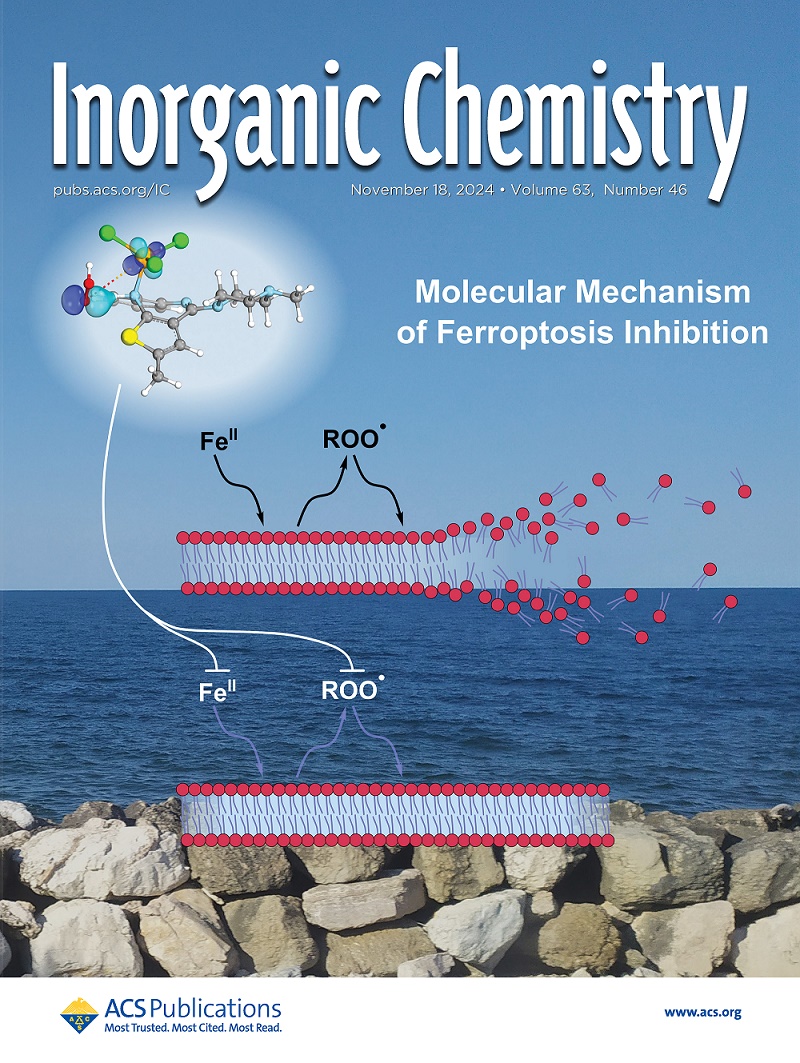锕系(II)二氧基在二嘧甲苷配体环境中的稳定性:DFT研究
IF 4.3
2区 化学
Q1 CHEMISTRY, INORGANIC & NUCLEAR
引用次数: 0
摘要
本研究旨在了解中-晚期锕系二氧离子[AnII(η - 1- 3o2)]2+ (An = Am-Lr)在+II氧化态下的性质及其与二嘧甲苷配体的相互作用。与锕系元素配位的7和8络合异构体的总结合能的DFT计算表明后者相对更稳定。在配合物中,Am、Cm和Lr转变为更稳定的+III氧化态,Bk到Es的氧化态在+II和+III之间,而Fm到No的氧化态保持在+II氧化态。从Mayer键序(O* -O键为~ 1.5)和自旋密度(O键为~ 0.5)可以观察到,三态双氧在络合后转变为双态超氧化物。基于键长和键序,An - n键表现出弱共价作用,而An -O *和An···O键表现出较强的共价相互作用。计算的热力学参数表明[An(O2)L]的生成是自发和放热的,其中[Cm(O2)L]和[Lr(O2)L]是热力学和能量上最可行的。能量分解分析对前者的共价特性的量化多于后者。相反,由于6d和7s轨道成键的可用性降低,[No(O2)L]是最不稳定的。本文章由计算机程序翻译,如有差异,请以英文原文为准。

Actinide(II) Dioxo Stabilization in the Dipyriamethyrin Ligand Environment: A DFT Study
This study aims to understand the properties of mid- to late-actinide dioxo cations, [AnII(η1-3O2)]2+ (An = Am–Lr) in their +II oxidation state and their interaction with the dipyriamethyrin ligand. The DFT calculations of the total binding energies of the complex isomers with 7 and 8 coordination to the actinide point to the latter as relatively more stable. In the complexes, Am, Cm, and Lr shift to a more stable +III oxidation state, Bk to Es were assigned oxidation states between +II and +III, while Fm to No retained their formal +II oxidation state. The triplet dioxygen transitioned to a doublet superoxide upon complexation, as observed from Mayer bond orders (∼1.5 for O*–O bonds) and spin density (∼0.5 on O). Based on bond lengths and bond orders, the An–N bonds show weak covalency, while the An–O* and An···O bonds exhibited stronger covalent interactions. The calculated thermodynamic parameters indicate the formation of [An(O2)L] to be spontaneous and exothermic, with [Cm(O2)L] and [Lr(O2)L] being the most thermodynamically and energetically feasible. Energy decomposition analysis quantifies more covalent character in the former than the latter. Conversely, [No(O2)L] is the least stable due to the reduced availability of 6d and 7s orbitals for bonding.
求助全文
通过发布文献求助,成功后即可免费获取论文全文。
去求助
来源期刊

Inorganic Chemistry
化学-无机化学与核化学
CiteScore
7.60
自引率
13.00%
发文量
1960
审稿时长
1.9 months
期刊介绍:
Inorganic Chemistry publishes fundamental studies in all phases of inorganic chemistry. Coverage includes experimental and theoretical reports on quantitative studies of structure and thermodynamics, kinetics, mechanisms of inorganic reactions, bioinorganic chemistry, and relevant aspects of organometallic chemistry, solid-state phenomena, and chemical bonding theory. Emphasis is placed on the synthesis, structure, thermodynamics, reactivity, spectroscopy, and bonding properties of significant new and known compounds.
 求助内容:
求助内容: 应助结果提醒方式:
应助结果提醒方式:


